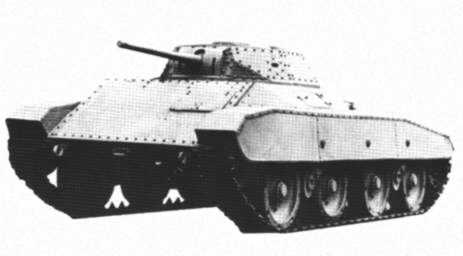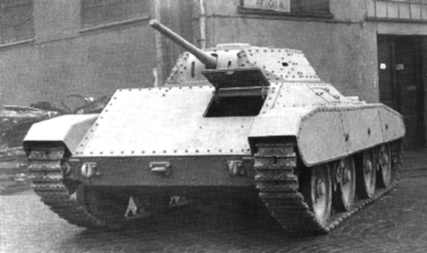Probably the most unknkown of the armored divisions. I


Probably the most unknkown of the armored divisions. I

Carro Armato M-11/39.
In 1933 it was clear the the tankettes were not the answer for replacing the overaging FIAT 3000s and a new tank was commisioned. After experimenting about a bigger and heavier 12 tons tank based on the CV.33 design, a lighter 8 tons tank version was chosen. In 1935 new tank appeared with its 37mm L40 gun with a limited traverse of 15º on the left and on the right and 12º on top and bottom thanks to an hydraulic device on the horizontal plane. The gunner seated on the right and the driver, lightly reared, on the left while the commander manouvered the turret two Breda 8mm MGs. The engine, still of commercial version, transmitted its move through a gear box to the forward sprocket. The drive was possible because of an epicyclic lever and the brakes.
M-11/39 Prototype.

Ground tests demonstrated that the vehicle needed improvements on the engine and transmission systems; a new rounded turret was designed to speed and make easier the production and so, in 1937, the new tank, designed “Carro di rottura” (breaktrough tank) was requested in a first (and only) batch of 100 exemplaries.
Lack of materials delayed the production until 1939 when it begun to be delivered with the signature M. 11/39 (which states for “Medium tank weighting 11 tons and accepted in service in 1939”): this vehicle was taller, heavier (about 10 tons) and hard to explain the tank was lacking the radio (that instead was mounted on the prototype).
In May 1940 24 M. 11/39s were sent in A.O.I. (“Africa Orientale Italiana”, Italian Eastern Africa) grouped in a “Compagnia speciale carri M.”, special M. tanks company to reinforce the Italian positions in the colony. On the start of the conflict field commands required new tank reinforcements because the light CV. 33s were unuseful, as demonstrated in first encounters with British armored units. 70 tanks were placed at disposal of the 4th Tank Regiment and landed in Bengazi in July of the same year.

When first employed against the English the M.11/39 got enough succes while being used in infantry support role during the first advance to Sidi Barrani. Similarly to the L. 33s this tanks were mechanically unreliable: in September when the Armored Groups were re-created the I Battailon of the 4th Tank Regiment’s 31 tanks only nine were still in service. The first engagements with the british tanks immediatly proved the inferiority and weakness of the M.11 in both gun and armor thickness and shape, without speaking about the weak trasmission/suspension system.
 A shot of the rear of a M. 39 captured by the British in North Africa.
A shot of the rear of a M. 39 captured by the British in North Africa.
The disaster was near: when the British launched their offensive in December 1940 the II Bataillon (2 M.11 companies) detached to Maletti Group was surprised near Nibeiwa and 22 of its tanks were knocked out. The I Battailon, while being part of the new Special Armored Brigade with a M.13 Battaillon and 2 L.33 battailons, was able to take only a minor part in the fight because the most part of its tanks were in Tobruk for repairs.
The following defeat in early 1941 took the destruction or the capture of almost all the M.11/39s: because of their unreliability and lack of any recovery vehicle the immobilized vehicles were abandoned in the enemy hands: the Australians equipped an entire regiment with the captured M.39 but they were soon put out of service because of their faults. The remnants six(!) tanks were used in Italy for training purposes and were officially put out of service after the armistice of September 1943.

Characteristics M-11/39:

Weigth: 10,970 tons
Crew: 3
Weapons: Vickers-Terni 37mm L40 gun with 84 rounds, 2 8mm MG Breda model 38 with 2800 rounds.
Armor: hull 8-30mm (nose 30mm, sloped plate 14mm, front 30mm, sides 14-15mm, top 8mm, bottom 7mm, rear 14mm); turret 7-30mm (front 30mm, sides and rear 14mm, top 7mm).
Engine: 43hp diesel FIAT Spa 8T, 8-cylinders on V, liquid cooled
Speed: 34Km/h
Autonomy: 200Km
Length (max)4,73m
Width: 2,18m
Height: 2,25m
Layout of the transporte device.

Gallery of light and Medium tanks, note the 20 mm AT rifle armed tankette.

Plate from “Italian Armored Vehicles of WW2” Squadron Armor.
Carro Armato L3 Light Tank

[LEFT]An experimental model produced by Fiat Ansaldo in 1937 on a chassis of a L.3 tankette. It had a 20mm Breda automatic cannon and an 8mm MG located in the turret much like the German Panzer II. This tank was never ordered into production.[/LEFT]
Can someone please post some photos of the M13/40?
Here you got M-13/40 and M-14/41, almost the same desing but the 14/41 was slightly heavier due the desert equipment.


The maximum armor was 35mm.

More pics of the M-14/41 and M-13/40 this are extracted from "Italian armored vehicles" Nicola Pignato, Squadron Armor.



One of the few advantages of this desing over the Britsh ones was that his 47mm gun was capable of fire HE ammo til 3500 meters, the 2 pounder gun only receive He ammo after the war in desert was over.
In the other hand the 47/32 mm gun was not very fast one with 640 m/s initial muzzle speed for his AP projectile.
in Rommel words "Is scary to see what kind of tanks the Duce has given to his soldiers" :roll:
And where Rommel speak I just keep a respectful silence.
Thanks Panzerknacker i asked because i am finishing my bersagileri diorama in the desert so i wanted to see if i missed something.And i did not :-)!!!
And i did not
You like the precise works. 
M-13/40 in color :

Characteristics of the M-13 armament, the penetration power of the Ansaldo 47/32 gun seems a little optimistic.

Source of the pics: same as above described.
serious piece of gear, Ariete had a lot by 1942, IIRC!
Timbo

Italian tank picture in color. The picture shows a 47mm Ansaldo 47/32 Gun. This tank was very much used in North Africa. With a AA gun and great muzzle velocity gave it a great fighting chance.
It is no doubt that Italian tanks played an important role in many of their victorys, but I would not want to be a tanker in one of the Italian tanks.
With a AA gun and great muzzle velocity gave it a great fighting chance.
Nice picture but the muzzle velocity of gun that war relatively poor, 630 m/s compared to 800 m/s of a british 2 pounder.
is no doubt that Italian tanks played an important role in many of their victorys, but I would not want to be a tanker in one of the Italian tanks
Rommel hated all the italian weapons (not the soldiers ) but you are corret most of the “PanzerArmee Afrika” was formed with italian armor.
In this video you can see italian armor and artillery, including the M-14/41 tank wich was the first vehicle to reach the Tobruk harbour when that fortress fell to the axis Forces in 21th June 1942.
[QUOTE=Panzerknacker;95089]Nice picture but the muzzle velocity of gun that war relatively poor, 630 m/s compared to 800 m/s of a british 2 pounder.
Thank you for pointing that out for me. Thanks for the compliment on the picture.
No problemo.

M-15/42:
This tank can be regarded as a product improvement of the M 14/41 though external resemblence is close. The tank is slightly longer and can be distinguished from earlier models by the lack of a crew hatch on the left side and the appearance of a crew hatch on the right.

The gun was longer, the turret was electrically traversed, speed improved, improved armor, and in general, a better ride.

82 of these tanks were built in 1943 before the war ended for Italy, but, these units did see action against the Germans. The rebuilt Ariete Division, located in Italy, took part in the Italian attempt to deny Rome to the Germans between 8 and 10 September 1943. The M.15s captured by the Germans were put to good use by their new owners.
The M15/42 Tank was an Italian World War II 15 ton tank first built in January 1943. Some 90 vehicles were built befor the Italian surrender in September 1943 and in connection to that event they were used in battle against the Germans by the Ariete armored division in Rome. After that point they were confiscated and used by the Germans who also built another 28 M15/42 tanks. Armament was once 47 mm main gun and for 8 mm Breda 38 machine guns.

GENERAL CHARACTERISTICS
crew:4
length:4.92 m
width:2.2 m
height2.4 m
weight:14.37 tonnes
ARMOUR AND ARMAMENT
armour:42mm
main armament 47 mm L/40 gun 111 rounds
secondary armament: 4x8 mm Breda 38 machine guns
MOBILITY
power plant: petrol 145 hp
suspension: vertical volute spring
road speed: 35km/h
range: 200km
Thank G.S, the 40 calibres gun of this tank had higher muzzle speed that the used in the M-13s.

Carro Armato Celere Sahariano.

Being impressed with the British cruiser tanks, the Italians attempted to make a copy for use in North Africa. The Carro Armato Celere Sahariano ( Fast Saharian tank) was clearly inspired by the Crusader, it had sloped armor and the 47 mm high velocity gun installed in a M-14/41 modified turret.

The hull employed a torsion bar suspension for improved cross country abilities. The tank can reach 60 km/h powered by a 270 hp Fiat diesel engine.

The war in ended before this AFV could be put on service and the project was cancelled. A 75mm main gun was proposed for production models.

I must say that your information is not correct. This AFV was produced in Spain, in the Sestao Naval Yards, during 1937. The Spanish Army accepted the prototype, but problems with the manufacture of armoured steel plates stopped this proyect. Italian advisors were present during the design phase, ant it is inspired both by the L33 and the Pz I.